For the majority of us reading this a brush with a parasite will be a fairly unremarkable episode. Hey, we’ve all had head lice, fleas and the odd case of worms – oh, maybe that’s just me. The point is these are generally just an irritation and not much more.
The collection of human parasites I’ve compiled below might start off fairly tame but soon accelerates into the realm of pure horror; there are flies that can drill into your brain, worms that can live in your eyeball and bugs that will put you to sleep forever. In theory a parasite has evolved in such a manner as to not kill its host, this would not be good for future generations. However, it seems that some of these miniscule monsters have not read the manual.
This list is possibly enough to convince many of you that there isn’t a God; or maybe these creatures are the result of intelligent design, but that designer is one sick puppy…
Some of you may be a little disappointed that I haven’t used the absolutely most gruesome pictures I could find. I’ll leave that to you now you are armed with a few names.
10. Bedbug

The bedbug is on the decidedly cuddly end of our most disgusting human parasites. These little insects are about the size of an apple seed and feed exclusively on blood, preferably human. You see that big straw like thing in the photo above, that’s for plugging into you and sucking your blood.
Whist a few people don’t seem too affected by bedbug bites for many it is somewhat like having masses of mosquito bites, and for others the bug’s saliva can trigger anaphylactic shock.
The bedbug is the most likely of this list of parasites that you will encounter. It was almost eradicated from the developed world back in the 1940s but unfortunately has made a comeback. One of the problems with these critters is how hard they are to get rid of. In the daytime they can hide in the tiniest of cracks, they can also stay hidden for months on end without feeding. You think you’ve got rid of them and then they suddenly reappear.
Whilst bedbugs may be a huge irritation to people think yourselves lucky you are not a female bedbug. Mating occurs through a process called traumatic insemination in which the male basically stabs the female in the abdomen to deliver his sperm.
Bed bugs get a place on this list partly as they give us a starting point, i.e. a 1 out of 10, and also because I had a nice photo!
9. Scabies mite

Just the word scabies alone sounds pretty unpleasant making it ideal for the skin condition it describes. Also known as the seven-year itch scabies results in intense itching and is contagious. It can occur virtually anywhere on the body, or across the whole body.
But itch as it might, and scratch as you will, it won’t help because scabies is caused by tiny parasitic mites living under the skin. So short of scratching your skin off it will keep on itching, so that’s what some people end up doing. This excessive scratching often results in secondary, bacterial infections which are far more of a health risk than the scabies itself.
Whilst normal scabies is an unpleasant experience, it is easily treated. However, a condition known as crusted or Norwegian scabies can occur in those with weaker immune systems. This hyper-infestation of mites can mean instead of a dozen or so there are actually millions of them crawling around under the skin.
8. Loa Loa
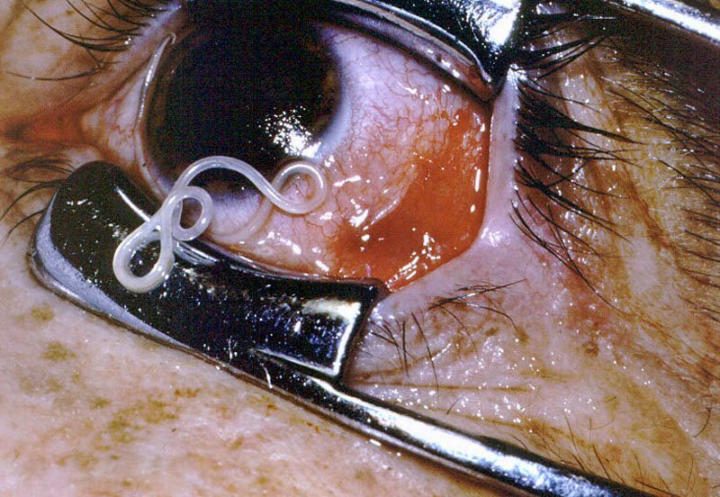
The nematode Loa Loa is our first (but not last) introduction to the worms. Although these little beast may be roughly the same shape as the worms you find in the garden that help the soil, that is pretty much where the similarity ends.
If you could think of a part of the body that you really didn’t want a parasitic worm to take up residence there is a good chance a lot of you would say the face or eye. Well, they don’t call it the “African eye worm” for nothing; infection with the loa loa worm (loaiasis) is often diagnosed by the presence of a worm in the eye. That’s a pretty horrific prospect as the adult worms measure between 3 and 6 cm (1.2–2.4 inches) long.
Apparently it can be quite painful as the worm slowly moves around, just under the surface of the eyeball. Perhaps the only consolation is that when they are clearly visible like this they can be surgically removed – a process which can be seen here.
As well as crawling around the eye the loa loa worm can spend many years crawling around under the skin. In fact these worms can live up to 17 years and will spend much of this time completely undetected – until one appears traipsing across the inner surface of the eye. This means a person may become infected many years before they realise, such as a case I read involving a woman who had visited Nigeria 6 years previously.
7. Paralysis tick
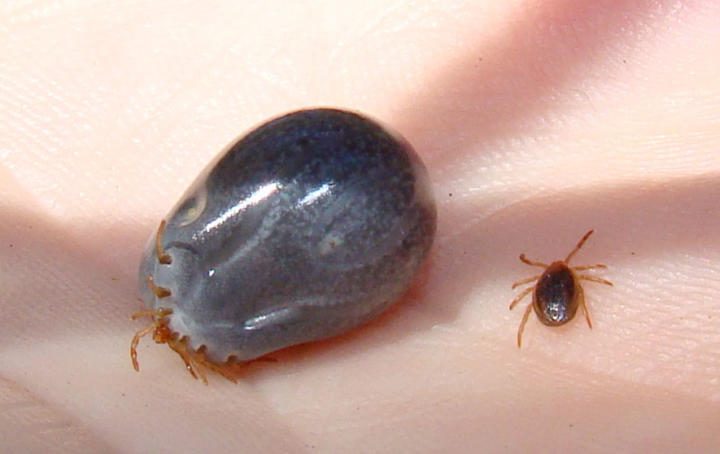
The Australian paralysis tick is a typically unpleasant antipodean arachnid. This is Australia of course so it shouldn’t be much of a surprise that this little nasty possesses a potentially lethal venom.
Paralysis ticks spend much of their time perched on leaves with their legs outstretched waiting for something or someone to brush past at which point they grab on. As with other ticks when a suitable host is encountered they will burrow head-first into the skin and start feeding on blood until they look fit to burst (see photo).
Like other ticks, the paralysis tick can pass on a number of nasty diseases such as Rickettsial infections or Lyme’s disease. Unlike other ticks this one secretes a neurotoxin that is capable of causing death by paralysis which progresses to the lungs causing respiratory failure.
Up until 1989 there were 20 recorded fatalities from tick paralysis in Australia. Whilst am increased awareness of the risks has eliminated much of the danger posed there is still no antivenom for this tick.
In addition to the toxin the paralysis tick often provokes an allergic reaction; this in itself can be life-threatening to some.
6. Guinea Worm

The picture of someone pulling a metre long worm out of someone’s leg should be enough to explain why this revolting parasite is on our list.
The guinea worm infects its host (humans or dogs) when they drink water that is contaminated with water fleas containing the worms larvae. Whilst the flea is digested by stomach acids, the larva is set free and begins its journey by penetrating the host’s stomach or intestine wall. It will live here in the body cavity for around 3 months where it mates with other guinea worms.
After around a year the female guinea worms will have grown to over 50cm (18ins) in length and are ready for the last stage of their journey. From the abdomen the worm makes its way down through the pelvis and along the bones of the leg towards the foot. This is usually the first sign of guinea worm infection (or dracunculiasis) and can give rise to an intensely painful burning sensation along the chosen path.
At some point they will reach the skin where the worm emerges from a blister to release hundreds of thousands of larvae when it encounters water. This stage is equally painful and associated with complications including severe allergic reaction.
Although it is very unusual for dracunculiasis to cause death it can be debilitating. There is also a risk of secondary infections if the worm dies en route.
The good news is that this parasite’s days appear to be numbered. Back in 1986 there were an estimated 3.5 million cases throughout Africa. Last year only 22 were recorded.
5. Chigoe flea

The chigoe, chigger or jigger flea is the smallest flea in the world and was originally only found in the tropical climates of South and Central America. Unfortunately, it has been accidentally spread to sub-Saharan Africa by human travel. Basically these tiny bundles of itchy hate will thrive anywhere warm where there is poverty and lack of hygiene. In areas where chigoe fleas are endemic the infection rate can be up to half the population.
As with many of the creatures on this list it is the female that is responsible for the parasites unsavoury reputation. Like other fleas, the male will hop on, suck the host’s blood and then hop off; the female, on the other hand likes to stick around. She will burrow head first into the skin leaving only a small part of the rear end protruding. This is for breathing, excretion and mating.
Infections are most common in the feet and the flea will go for areas of soft skin, such as between the toes. This is because the jigger flea lives just under the soil surface, waiting for an unfortunate mammal host to come along, at which point it will hop on.
Once established the flee will begin feeding on the host’s blood and grow from around 1mm to the size of a small pea, all under the skin. The first sign of chigoe infection has been described as a “pleasant” itching, however, this does not last long, becoming more intense. Other signs include bumps on the skin with tiny coils of flea poo protruding. After a while the itching may be accompanied by pain, sometimes severe, as the flea expands within its burrow.
Unpleasant as the actual flea’s presence may be, it is the host of accompanying complications and secondary infections that cause the biggest problems. Tetanus and gangrene are not uncommon, along with around 150 other pathogens carried by the fleas. Most of these infections occur when the flea has died and begins to rot away under the host’s skin.
4. Filariasis

For easily understandable reasons the disease caused by filarial worms is often mistakenly referred to as “elephantitis“, the actual name of the condition is elephantiasis. It is odd to think the gross deformities seen in this condition are actually caused by tiny roundworms which are spread via mosquito bites. This explains why it took until the late 1800s for the connection to be made by the medical world.
A simple explanation of the cause of the massive swelling is the damage and blocking of the lymphatic vessels by the filarial worms which causes a build up of lymph fluid in the tissue. This generally affects the lower regions of the body and can be particularly cruel for men as the swelling often causes the testicles to become massive. A quick online search will reveal photos of unfortunate victims with balls the size of space-hoppers.
It is estimated that worldwide more than 120 million people are infected with filarial worms. For the majority there are little or no signs of the infection; for the rest there is a lifetime of social stigma and incapacity. In some communities though, where lymphatic filariasis is endemic elephantiasis can affect up to 50% of the population.
The outlook for those suffering from elephantiasis is mixed. Surgery can be successful in some cases, but not many. The worms also live a long time – up to 14 years, and during this time they will reproduce, so this condition is often for life.
3. Ascaris
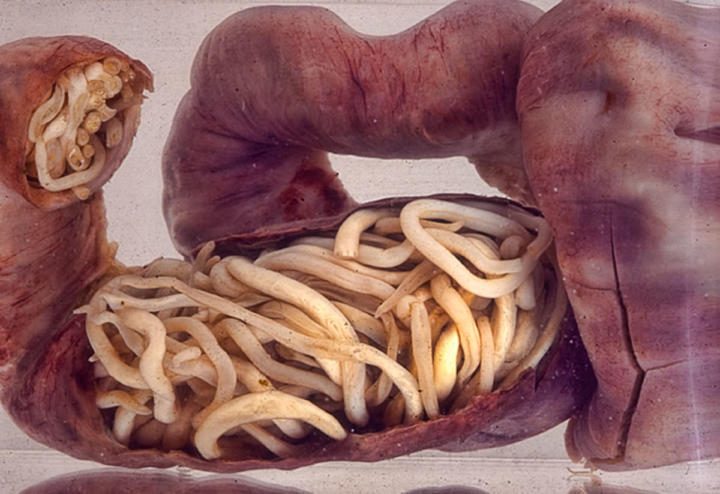
To some extent the picture above pretty much sums up the horrors inflicted by the roundworm, Ascaris lumbricoides. This writhing ball of worms (and section of bowel) was removed from the intestine of a 3 year old South African child. In a similar case a 2 year old child, who died, was found to have had nearly 800 worms weighing 0.5Kg (1lb) inside her.
Although the above are fairly extreme cases ascaris infection (ascariasis) is incredibly common. In fact around a fifth of the global population have some degree of ascaris infection. Most show no symptoms, whilst a small percentage present with abdominal pain and sometimes weight loss.
Ascaris worms can grow to a length of 35 cm (1ft) and live by feeding off the undigested food within our gut so it is little wonder that having a few of these can leave you feeling hungry.
Along with bowel obstruction, other serious complications can occur. Some worms may find their way into the pancreas or gallbladder – which I believe is highly painful. These conditions usually require surgery, which can be very unpleasant given ascaris worms have an aversion to certain general anesthetics and may try to exit the body via the mouth.
Another potentially serious complication is caused by the migrating larvae. As part of their life cycle the microscopic larvae are absorbed from the gut into the blood system and find their way into the lungs. Here they can cause damage before being coughed up, swallowed and returned to the gut. This was the case in a bizarre attempted murder trial in Canada. PhD parasitologist Eric Krantz was accused of trying to kill his housemates by serving food infected with ascaris eggs he had procured from the university labs. The housemates ended up in hospital for 2 weeks with parasitic pneumonia.
In the ensuing trial Krantz was acquitted on the grounds of reasonable doubt.
2. Tapeworm
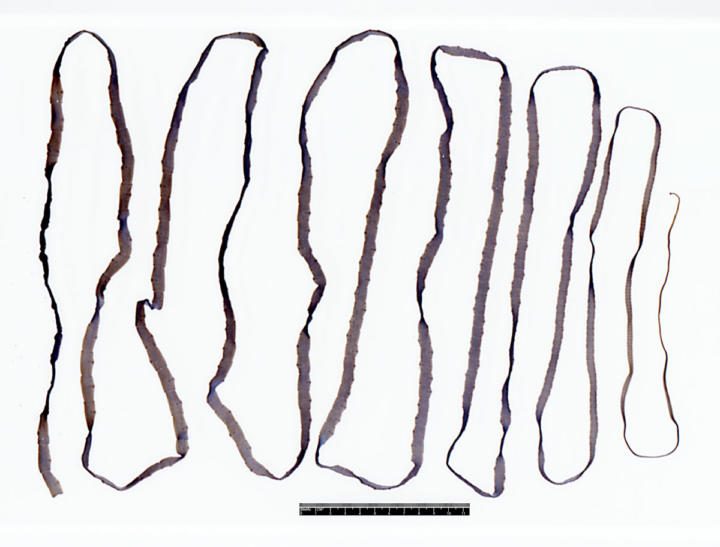
Back to the worms with the biggest of them all – the mighty tapeworm. This family of flatworms are the largest human parasite and survive by attaching themselves to the lining of the intestines where they feast on blood. Whilst admittedly this doesn’t sound like much fun for them, it isn’t particularly great for the host either; symptoms include a range of abdominal conditions and in severe cases weight loss and anaemia.
It was probably quite a severe case of the tapeworms that Sally Mae Wallace of Great Grits, Mississippi had back in 1991. Whilst most of us would probably want to keep such things private Sally appears proud of the fact a record breaking 11 metre (37 ft) worm was removed by doctors, via her mouth. She is quoted as chirping “after about 20 feet of that thing had come out of my mouth, I just knew I had the record. I was really filled with joy”. And who wouldn’t be?!
If you think that all sounds bad then pity the poor whales. Their version of the tapeworm (Polygonoporus giganticus) can grow to over 30 metres (100 ft) in length.
Although this is all quite disgusting, it isn’t really life threatening. Unfortunately this isn’t always the case – the pork tapeworm (Taenia solium) can cause serious problems and even death. This can occur when one of the tapeworm’s segments ruptures releasing thousands of eggs. These hatch into tiny larvae which migrate to various body tissues causing what is known as cysticercosis. Here they remain dormant for weeks, months or even years after which they begin to grow, up to nearly 2cm across. This can affect the muscles, skin and even the eyes and brain. You can probably imagine the problem this causes with blindness, seizures and ultimately death in some cases.
1. Screw-worm fly / myiasis in general
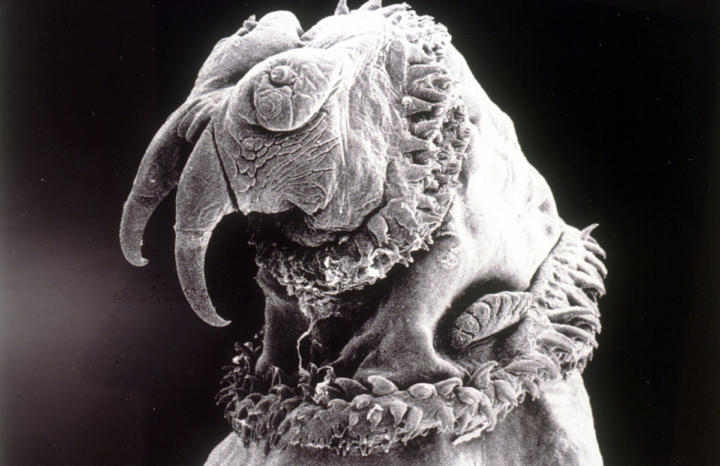
The New World screwworm may not be the most prolific of the parasites on this list, but it makes up for this in sheer horror. Screwworms are a well known livestock pest but they are equally at home on any warm-blooded animal… or human. In fact the species name (hominivorax) roughly translates as “man-eater” and that is kind of what they do.
The life cycle of the screwworm begins with an adult female fly looking for an open wound to lay her eggs in. When a suitable host is found in excess of 100 eggs may be laid in and around the wound and these hatch into tiny larvae within 24 hours. In order to grow these little grubs need food, and this is where things become the stuff of nightmares. Using its cutting jaws and those nasty looking fangs, the screwworm begins burrowing into the host’s flesh, eating as it goes.
These maggots can drill all the way down to the bone, bite into nerves or even get into the bloodstream; the possibilities are endlessly horrific. One particularly unpleasant trait of the screwworm is its habit of burrowing deeper if it is disturbed. And all this isn’t just grotesque, it’s life-threatening – including resulting secondary infections the mortality rate from screwworm infestation is 8%.
Today the screwworm is only found in areas of Central and South America (it was successfully eradicated in the U.S. in the 1950s). It was in Peru that a British tourist had a very unpleasant experience with these little flesh-eating monsters. Rochelle Harris had just returned from her holiday when she began noticing a scratching noise that seemed to be coming from inside her head. Other symptoms such as headaches, shooting pains in her face and a discharge from her ear followed.
Initially dismissed as an ear infection it was only when Rochelle visited a specialist that the grim discovery was made. Whilst examining her ear the doctor suddenly went quiet. Following an emergency brain scan it was discovered that the maggots had burrowed over a centimetre into Rochelle’s head from a hole in her ear canal. A visual examination revealed what doctors described as “‘writhing mass of maggots”. Luckily for Ms Harris the parasites were removed before they had caused any serious damage.
Thanks for the heads up. Think I’ll skip Peru and associated countries on my travels.
Peru means cancel! in Finnish 🙂
It means “turkey” in Portuguese…